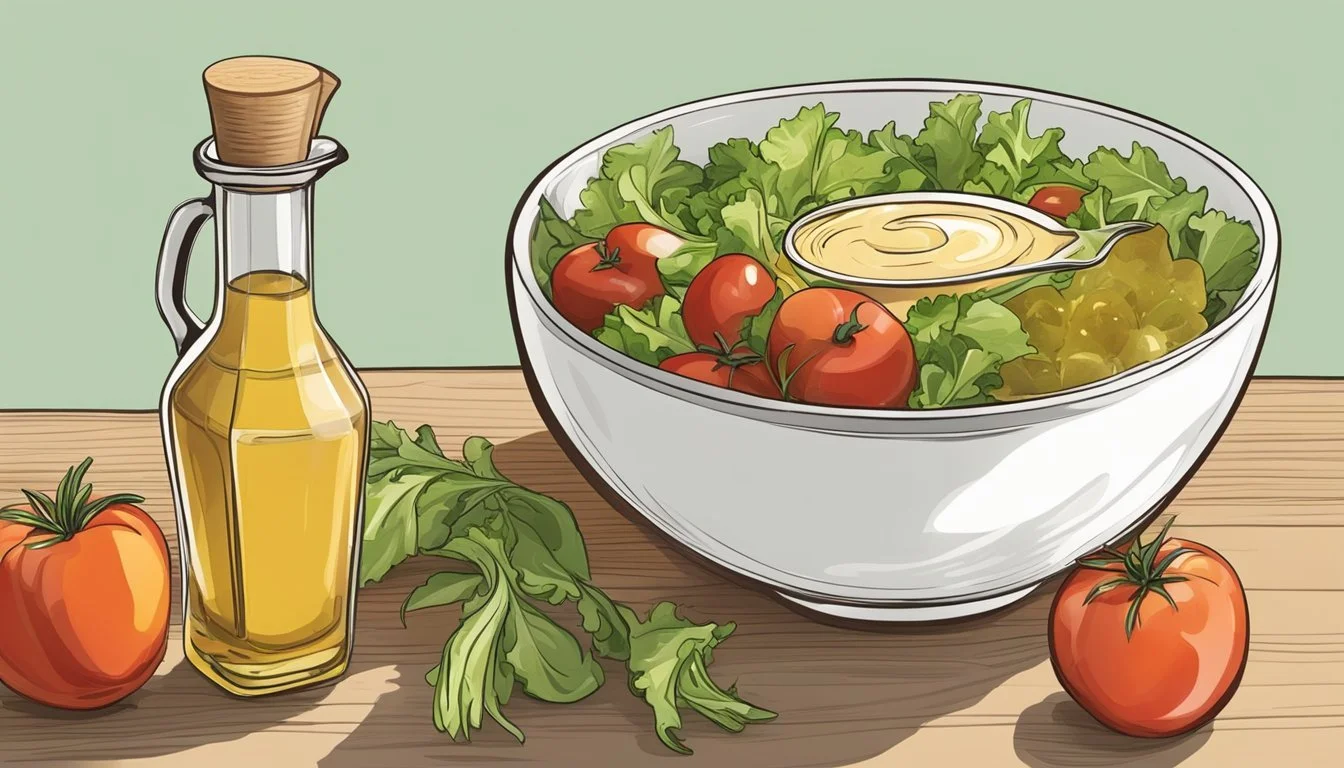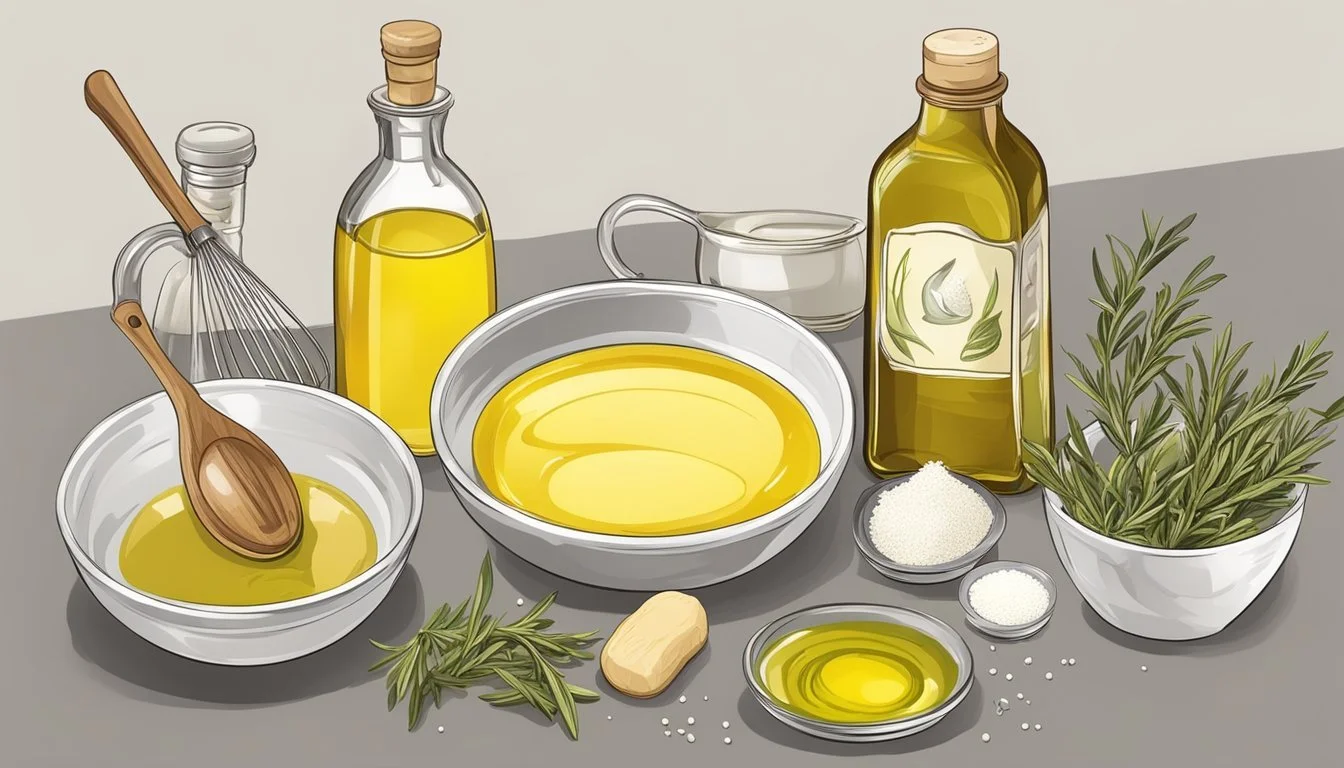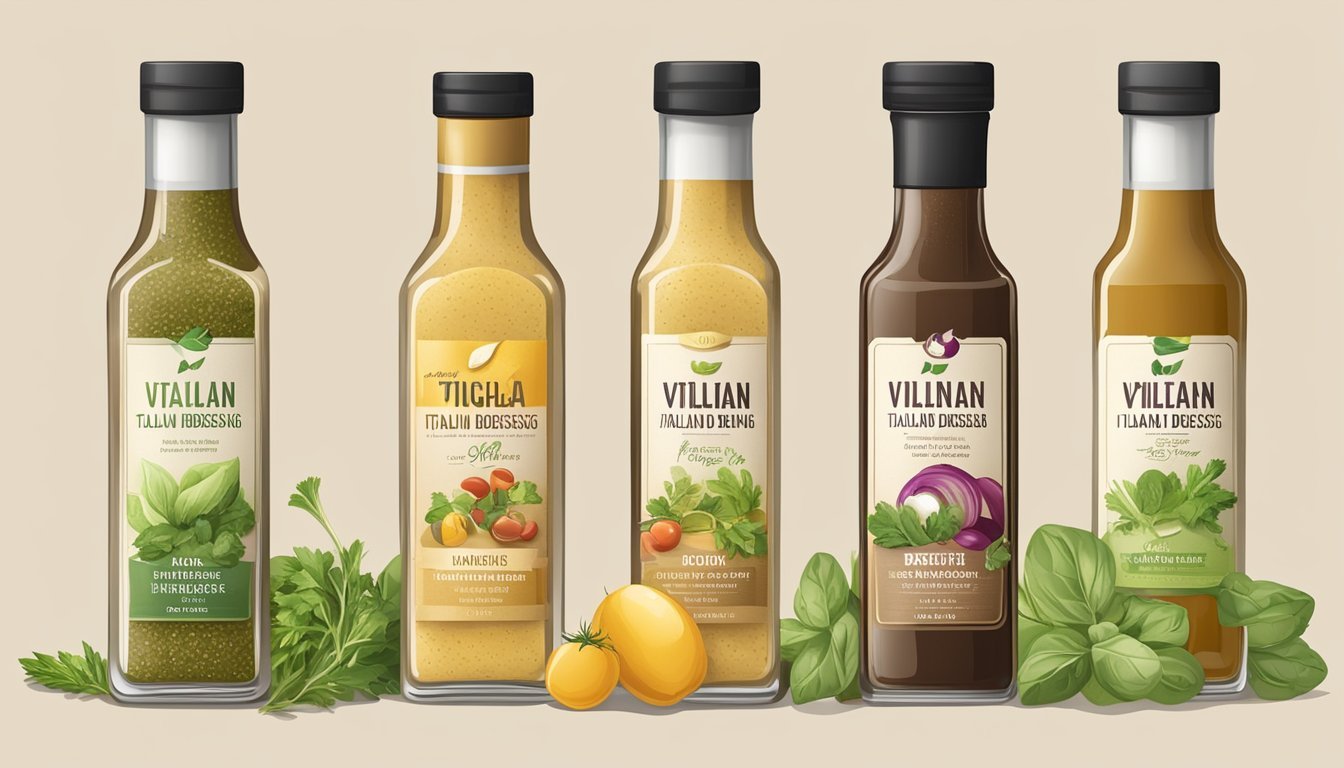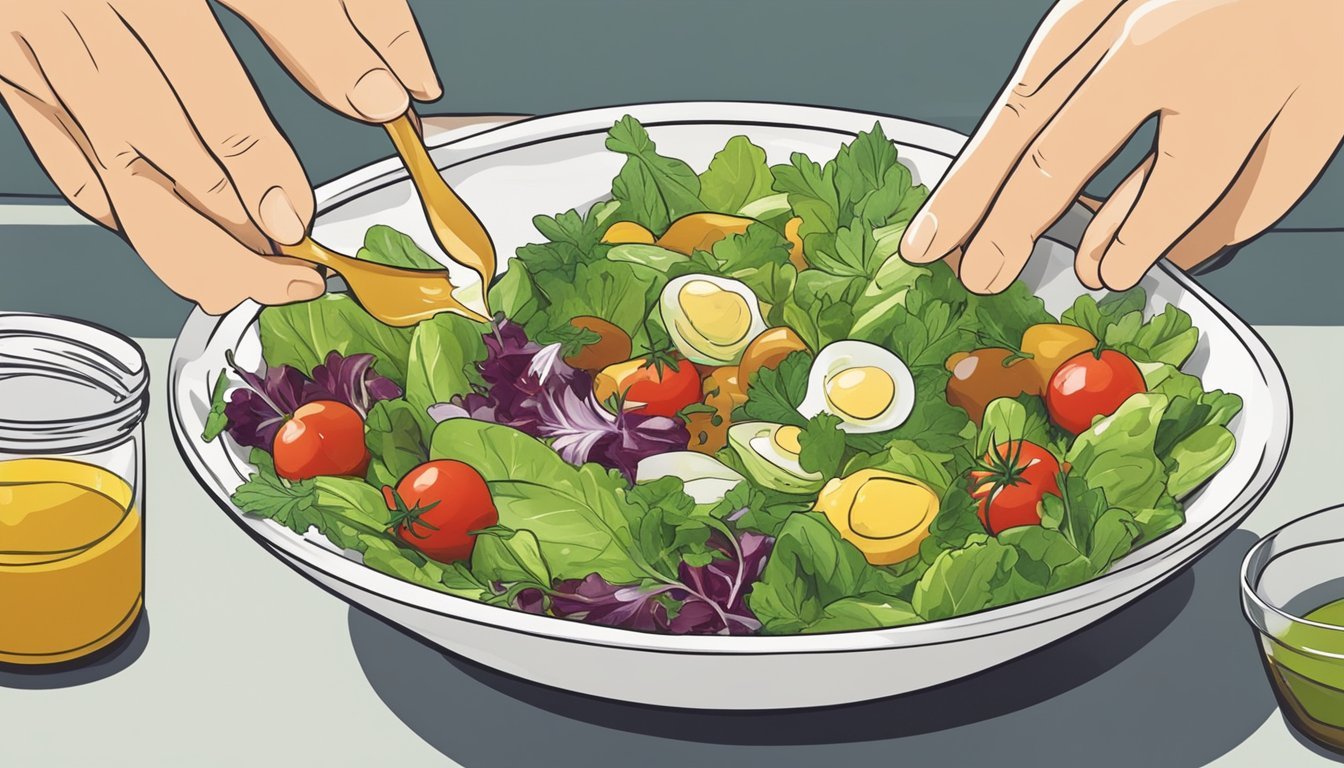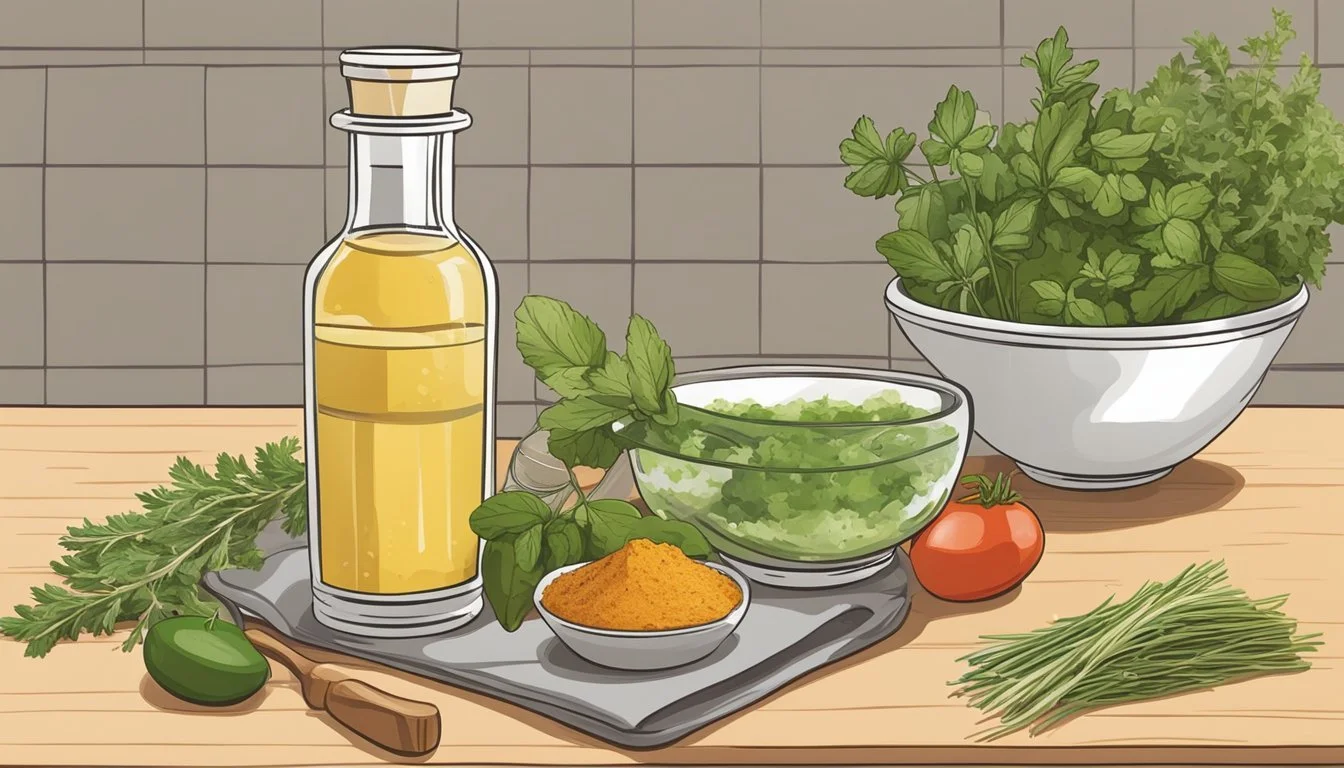How to Substitute Vinaigrette for Italian Dressing
A Simple Swap Guide
Italian dressing is a popular choice for salads (What wine goes well with salads?) and marinades, offering a balanced mix of herbs, vinegar, and oil that brings a flavorful touch to various dishes. However, when Italian dressing isn't available, or someone is seeking a lighter alternative with a different flavor profile, vinaigrette can be an excellent substitute. A vinaigrette is typically made from oil and vinegar, and the variations are endless, allowing it to cater to a wide range of tastes and recipes.
To successfully substitute vinaigrette for Italian dressing, it is essential to understand the key components that give Italian dressing its character. Italian dressing is notable for its blend of olive oil, vinegar, and a medley of Italian herbs such as oregano, basil, and garlic. Achieving a similar taste requires replicating this harmony of ingredients within the vinaigrette.
Incorporating these elements into a vinaigrette involves choosing the right type of vinegar—preferably red or white wine vinegar—and adding a combination of herbs and seasonings to mirror the flavors found in Italian dressing. The versatility of vinaigrette, coupled with the selection of high-quality ingredients, allows for a seamless transition between the two dressings while maintaining the essence of the dish.
Understanding the Basics of Italian Dressing
Italian dressing is a vinaigrette-type condiment that is often used to add zest and flavor to salads. The foundation of Italian dressing is olive oil and vinegar, with the oil and vinegar ratio being a pivotal factor in achieving the right balance of flavor and consistency.
The customary oils used are typically of the olive variety, with extra virgin olive oil being a preferred choice for its rich taste and health benefits. The vinegar component often involves either red or white wine vinegar, which lends a sharp and tangy flavor profile to the dressing.
Seasonings play a critical role in defining the dressing's character. A standard Italian dressing will include herbs like oregano and basil, along with garlic to infuse a pungent and aromatic depth. Salt and pepper are added to taste, enhancing the overall savoriness of the dressing.
To create an Italian dressing, one would:
Emulsify olive oil and vinegar to form a cohesive blend.
Incorporate seasonings, finely minced or powdered, to infuse flavor.
Adjust the seasonings, including salt and pepper, according to personal preference.
Italian dressing isn't merely a salad topper. Its versatility extends to being a marinade for meats or a flavor enhancer for sandwiches and pastas.
Ingredient Purpose Olive Oil Base for richness and smooth texture Vinegar Adds acidity and sharpness Oregano Provides a classic Italian herb note Garlic Offers a strong, aromatic component Salt Enhances taste Pepper Adds mild heat and complexity
This dressing, when balanced correctly, yields a harmonious blend of tanginess, herbal notes, and garlic depth, making it an enduring favorite in condiment selections.
Examining Vinaigrette Components
A vinaigrette is typically a blend of oil and vinegar, the two foundational components balanced in harmony to create a light, yet flavorful dressing. While olive oil is the most common oil used due to its fruity notes and health benefits, other oils may also be employed based on personal preference or desired flavor profile.
Olive oil: High-quality extra virgin olive oil imparts a depth of flavor.
Vinegar: Provides the characteristic acidity, with options such as red or white wine vinegar, or even balsamic for a sweeter twist.
In addition to oil and vinegar, vinaigrettes often incorporate an emulsifying agent, like mustard, to blend and stabilize the mixture. Mustard not only helps in forming a smooth emulsion but also adds a subtle spice to the dressing.
Mustard: Generally Dijon, it creates an emulsion and adds complexity.
A citrus element, such as lemon juice, can be added to impart a fresh, zesty kick, substituting or complementing vinegar to modify the tartness of the vinaigrette.
Lemon juice: Offers a bright, fresh acidity that can enhance or replace vinegar.
Compared to Italian dressing, which may include a host of other ingredients such as various herbs and garlic, vinaigrettes keep it simple. By understanding these components, a cook can effectively substitute or mimic the Italian dressing's vibrant character with a homemade vinaigrette. Potential adjustments can be made in the ratio of oil to acidity or by adding seasonings to align closer with the flavor profile of Italian dressing.
Differences and Similarities
When it comes to Italian dressing and vinaigrette, they both serve as popular salad dressings that effectively enhance the flavor of greens and vegetables. They are both oil-based dressings, yet they possess distinct differences and share certain similarities in terms of ingredients and culinary usage.
Vinaigrette is a mixture typically made of a simple blend of oil and vinegar, often seasoned with salt, pepper, and sometimes herbs. The standard ratio for a classic vinaigrette is 3 parts oil to 1 part vinegar. This can be varied according to taste and the desired acidity level.
Italian Dressing Vinaigrette Often contains a blend of vinegar, oil, and a variety of herbs and spices Generally made of oil, vinegar, and sometimes just basic seasonings Includes extra ingredients such as bell peppers, sugar, garlic, and sometimes red wine vinegar Focuses on the balance between the simplicity of oil and the sharpness of vinegar Has a distinctively robust and herbaceous flavor profile Offers a versatile flavor that can range from light and tangy to bold and acidic
Italian dressing typically includes more ingredients compared to the basic vinaigrette, introducing more complex flavors. Common additions include garlic, oregano, basil, and sometimes sweeteners or emulsifiers. While Italian dressing may use a variety of vinegars, balsamic or red wine vinegar is common, which contributes to its savory, tangy profile.
In practical use, both dressings can often be substituted for one another in salads, although the flavor profile will shift. Italian dressing due to its additional herbs and spices may offer a more pronounced taste, while a straight vinaigrette provides a clean, acidic note allowing the natural flavors of the salad components to shine.
Creating Your Italian Dressing Substitute
To craft a flavorful Italian dressing substitute, one begins by selecting a base of high-quality extra virgin olive oil. The oil serves as the foundation, providing a rich texture and depth of flavor.
Vinegar is the next crucial component, with red or white wine vinegar being the preferable choice for their authentic tanginess. In absence of these, any available vinegar can suffice.
Seasonings play a pivotal role in mimicking the complexity of Italian dressing. Garlic, either freshly minced or in powder form, infuses the concoction with its signature aroma and taste. Basil and oregano lend their distinct herbal notes, while salt and pepper ensure a balanced seasoning profile.
If a hint of sweetness is desired, consider incorporating a touch of sugar or honey. Conversely, for an emulsified texture and slight tangy kick, mustard can be a welcome addition.
Those looking for a touch of umami might like to grate some parmesan cheese into the mix. This element enhances the dressing with a savory, cheesy quality.
A simple homemade Italian dressing recipe might include:
Olive oil: ¾ cup
Vinegar (preferably red wine): ¼ cup
Garlic: 2 cloves, minced
Dried oregano: 1 tablespoon
Dried basil: 1 tablespoon
Mustard: 1 teaspoon
Honey (optional): 1 teaspoon
Salt and pepper: to taste
Combine these ingredients vigorously in a jar with a tight-fitting lid or whisk them together in a bowl. For best integration of flavors, let the dressing rest for a few hours before usage.
Through these steps, one can achieve a substitute with the harmonious flavors of traditional Italian dressing, tailored to the individual's palate and available ingredients.
Enhancing Flavors with Additional Ingredients
When substituting vinaigrette for Italian dressing, one can enhance the flavor by incorporating a variety of additional ingredients. Incorporating grated Parmesan cheese adds a nutty and salty depth that pairs well with the tanginess of the vinaigrette. For a robust aroma, one might consider adding garlic powder, or better yet, fresh minced garlic for a pungent kick.
Italian seasonings such as oregano and basil lend an herby brightness to the vinaigrette, evoking the classic Italian dressing profile. Citrus notes can be introduced with a splash of lemon juice, which provides a fresh zing. Vinegar is critical for the acidic component, and options include:
White wine vinegar: a milder choice that adds a gentle tartness.
Red wine vinegar: imparts a sharper vinegar flavor, closely mirroring that in traditional Italian dressing.
Balsamic vinegar: offers a sweet complexity and can be used sparingly to avoid overpowering the vinaigrette.
Those desiring a creamier texture can mix in mayonnaise or sour cream. For a thinner consistency with a tangy flavor, buttermilk is an excellent choice.
To balance the acids, including a sweet element is key. Choices for sweeteners involve:
Sugar: for a classic sweetness.
Honey or maple syrup: for a natural, nuanced sweetness.
Dijon mustard adds a touch of spice and emulsification, helping the vinaigrette to blend smoothly. Finally, for those who enjoy a hint of the sea, finely chopped anchovies (What wine goes well with anchovies?) or capers (What wine goes well with capers?) can be added for a briny undertone.
When adjusting flavors, using fine sea salt allows for precise seasoning control. Experimentation and tasting during preparation assure the best results tailored to individual palates.
Substituting Vinaigrette in Recipes
When replacing Italian dressing with vinaigrette in salads, one must consider the balance of flavors. Vinaigrette, typically a mixture of oil, vinegar, and herbs, can serve as an excellent base. For instance, in a pasta salad or green salad, a vinaigrette made with red wine vinegar complements the freshness of the ingredients. To align closer to the Italian dressing's flavor profile, one might add a mix of dried Italian herbs, such as basil and oregano, and perhaps a bit of grated Parmesan cheese.
For a marinade, especially for chicken, vinaigrette provides a tangy infusion that tenderizes the meat. A ratio of three parts oil to one part acidic element, like vinegar or lemon juice, works well. Adding ingredients such as minced garlic and Dijon mustard can inject a depth of flavor reminiscent of Italian dressing.
In the case of Italian salad, vinaigrette offers flexibility. One can modify it to taste by including a bit more sweetness or a tangier element like lemon juice. This ensures the character of the original dish remains intact while introducing the zesty flair of vinaigrette.
Reflecting on sandwiches and pizzas, vinaigrette performs admirably when brushed on bread as a lighter substitute or drizzled over roasted vegetables before serving. The oil-based dressing crisps the bread in sandwiches and adds a layer of richness to the roasted textures of the vegetables.
It is best to avoid overly robust vinegars in vinaigrettes used as substitutes for Italian dressing to maintain a pleasant taste balance. A simple concoction might include olive oil, a milder vinegar like apple cider vinegar, a pinch of sugar, and a squeeze of fresh lemon, accented with salt and pepper.
In summary, when subbing vinaigrette for Italian dressing, season thoughtfully to align with the dish's intended flavor profile while reaping the benefits of vinaigrette's versatile nature.
Storing and Serving Suggestions
When substituting vinaigrette for Italian dressing, proper storage is vital to maintain freshness and flavor. For homemade dressing, one should ideally store it in a mason jar or any airtight container. This method keeps the dressing fresh for up to a week when refrigerated.
One should keep leftover store-bought vinaigrette similarly refrigerated, tightly sealed to prevent spoilage; however, they often contain preservatives that extend their shelf life beyond homemade versions. Always check the expiration date and follow the storage instructions on the label.
Here are some simple yet effective storage and serving tips to ensure your vinaigrette remains as flavorful as possible:
Refrigeration:
Freshness is key, so keep both homemade and store-bought dressings chilled.Airtight Containers:
Mason jars are ideal for this purpose, helping to keep the dressing from absorbing unwanted odors.Shaking before serving:
Ingredients may separate, so always shake your dressing right before drizzling it onto dishes.
For serving, a vinaigrette's bright acidity and flavor are a perfect complement to:
Food Item Suggested Use Salads Toss lightly to coat leaves without wilting them Grilled Vegetables A drizzle can add a zesty brightness Sandwiches Use as a flavorful alternative to mayo Marinades Enhance meats before cooking with a tangy twist
Remember, when serving, start with a small amount and add more to taste to ensure the dressing does not overpower the dish.
Exploring Other Dressing Variations
When substituting for Italian dressing, it's essential to consider the flavor profile of the original dressing. Italian dressing typically combines oil, vinegar, herbs, and spices. Other dressings can be used, but they will bring their unique taste to the dish.
Ranch dressing is creamy with a tangy buttermilk flavor, making it a richer alternative. It can work well in pasta salads or as a marinade for chicken where a creamy texture is desired.
Greek dressing, similar to Italian in its use of herbs and oil, tends to include more lemon juice and sometimes Greek yogurt for added tang and creaminess. This makes Greek salad dressing a good substitute when a more Mediterranean flavor is desired.
Caesar dressing and its creamier variant, creamy Caesar dressing, offer a robust flavor with anchovy and parmesan notes. They can substitute Italian dressing when a zestier, umami-rich profile is sought after.
French dressing offers a sweet and tangy taste due to the presence of ketchup and sugar, adding a different dimension to salads that require a subtle sweetness.
To achieve a balance between sweetness and tang, honey mustard dressing is an excellent choice. It combines the velvetiness of honey with the sharpness of mustard and can complement salads with fruit components.
Zesty Italian dressing is a more intensively flavored version of Italian dressing, with additional spices and sometimes spicy elements like red pepper flakes. It is the closest substitute for Italian dressing, maintaining the herbaceous quality while amplifying the zest.
Dressing Type Main Components Flavor Profile Ranch Dressing Buttermilk, herbs, garlic Creamy, tangy Greek Dressing Olive oil, lemon juice, Greek yogurt, herbs Tangy with a Mediterranean flair Caesar Dressing Anchovies, garlic, parmesan cheese Zesty, umami-rich Creamy Caesar Mayonnaise, anchovies, garlic, parmesan cheese Richer and creamier than classic Caesar French Dressing Ketchup, vinegar, sugar Sweet and tangy Honey Mustard Honey, mustard Sweet and sharp Zesty Italian Olive oil, vinegar, red pepper flakes, herbs Herbaceous with a spicy kick
These alternatives provide a diverse palette of flavors, which can enhance or modify the overall taste of a dish when used in place of Italian dressing.
Considerations for Health-Conscious Choices
When substituting Italian dressing with vinaigrette for health-conscious individuals, it's important to consider the components of the dressing. A vinaigrette typically consists of oil and vinegar, offering a lighter alternative with potential health benefits if the right ingredients are chosen.
Oil: Opting for extra-virgin olive oil is a health-conscious choice because of its high content of monounsaturated fats, which are known to be heart-healthy. It also contains antioxidants that can contribute to reducing inflammation.
Vinegar: There are various options, such as balsamic vinaigrette, white vinegar, and red or white wine vinegar. Balsamic vinaigrette adds a unique sweet-tart flavor and contains antioxidants. The wine vinegars provide a robust tang and can have beneficial effects on blood sugar levels.
Vinegar Type Flavor Profile Potential Health Benefit Balsamic Vinaigrette Sweet-tart Antioxidants White Vinegar Sharp, Clean Antimicrobial properties Wine Vinegar Robust, Tangy May aid in blood sugar control
For an even healthier dressing, one might consider using less oil and more vinegar to reduce the overall calorie content. Seasonings such as garlic, mustard, and herbs not only enhance the taste but also provide additional health benefits without contributing significant calories.
When creating a vinaigrette, individuals should also be aware of the sodium content often present in store-bought Italian dressings. Homemade vinaigrettes allow for control over the amount of added salt, making it a favorable choice as a part of a sodium-restricted diet.
By consciously selecting ingredients like extra-virgin olive oil and various vinegars, people can enjoy a delicious substitute for Italian dressing that aligns with a healthy lifestyle. Each ingredient contributes its own set of health benefits, offering more than just flavor to any dish.
Summary and Final Thoughts
Substitutes for Italian dressing offer a versatile and economical alternative that can be tailored to fit various preferences and dietary restrictions. When a recipe calls for Italian dressing and none is at hand, a vinaigrette can easily take its place. Food writers often recommend a simple blend of olive oil and vinegar seasoned with herbs as a reliable stand-in.
Homemade Salad Dressings:
Versatility: Homemade vinaigrettes are incredibly adaptable, able to cater to taste by adjusting the acidity or the inclusion of different herbs.
Economical: Creating dressings from scratch is cost-effective, utilizing common pantry items without the need for a store-bought counterpart.
Key Points to Remember:
Proportions: Maintain the classic vinaigrette ratio of three parts oil to one part vinegar for the base.
Seasonings: Enhance with seasonings such as garlic, oregano, or basil to emulate Italian dressing's signature flavor profile.
Acidity: Utilize red or white wine vinegar for a more authentic taste, though other vinegars can be used depending on availability.
One should approach dressing substitution with confidence. It should be noted that while vinaigrettes are an excellent substitute for Italian dressing, they have a distinct taste. Therefore, individuals should adjust the seasonings to achieve a desirable balance of flavors. Homemade dressings not only serve as a quick fix but can become a preferred option for the freshness and customization they allow.
Appendix: DIY Italian Dressing Recipes
For those seeking to create Italian dressing from scratch, this appendix provides a selection of concise, do-it-yourself recipes. Utilizing common pantry ingredients, these recipes deliver authentic, homemade Italian dressing flavors.
Classic Italian Dressing:
Ingredients:
3/4 cup olive oil
1/4 cup red wine vinegar
2 tbsp water
1 tsp garlic powder
1 tsp dried oregano
1 tsp onion powder
1/2 tsp salt
1/2 tsp sugar
1/4 tsp red pepper flakes
Instructions:
In a jar with a tight-fitting lid, add all the ingredients.
Shake vigorously until the mixture is well-blended and emulsified.
Taste and adjust salt if necessary.
The dressing can be stored refrigerated for up to 2 weeks.
Creamy Variant:
Follow the Classic recipe but add:
1/4 cup grated Parmesan cheese
1/4 cup mayonnaise or Greek yogurt for a healthier choice
Instructions:
Combine the additional creamy ingredients with the Classic recipe.
Shake well until homogeneous.
This version should be used within 5 days when refrigerated.
Alternative Seasonings: Table of alternative seasonings:
Ingredient Quantity Description Fresh garlic 1 clove Minced, for a more robust garlic flavor Dried basil 1 tsp Instead of or in addition to oregano Fresh oregano 1 tsp For an aromatic lift, finely chopped
These homemade Italian dressing recipes offer individuals a way to quickly concoct a delectable, versatile condiment ideal for salads and marinades.

